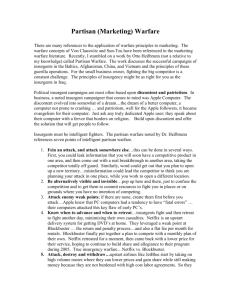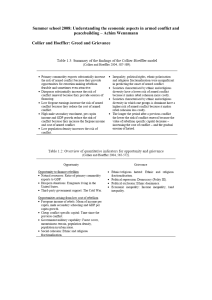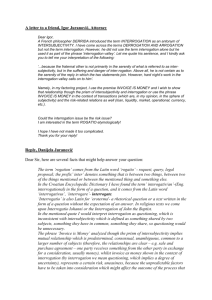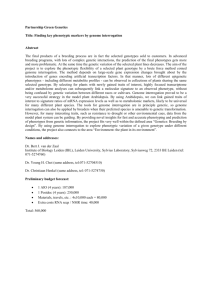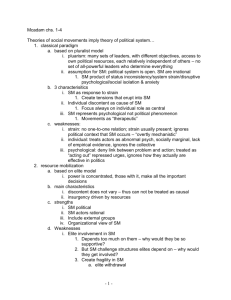INTERROGATION SUPPORT TO LOW-INTENSITY CONFLICT • APPENDIX I
advertisement
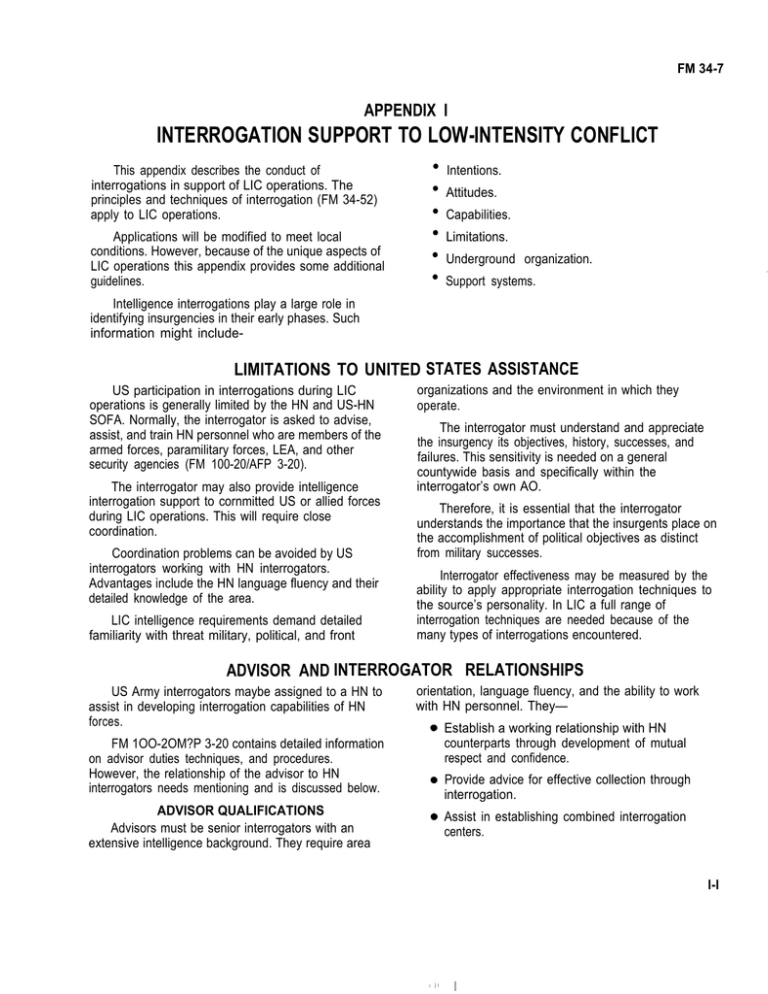
FM 34-7 APPENDIX I INTERROGATION SUPPORT TO LOW-INTENSITY CONFLICT This appendix describes the conduct of interrogations in support of LIC operations. The principles and techniques of interrogation (FM 34-52) apply to LIC operations. Applications will be modified to meet local conditions. However, because of the unique aspects of LIC operations this appendix provides some additional guidelines. • • • • • • Intentions. Attitudes. Capabilities. Limitations. Underground organization. Support systems. Intelligence interrogations play a large role in identifying insurgencies in their early phases. Such information might include- LIMITATIONS TO UNITED STATES ASSISTANCE US participation in interrogations during LIC operations is generally limited by the HN and US-HN SOFA. Normally, the interrogator is asked to advise, assist, and train HN personnel who are members of the armed forces, paramilitary forces, LEA, and other security agencies (FM 100-20/AFP 3-20). The interrogator may also provide intelligence interrogation support to cornmitted US or allied forces during LIC operations. This will require close coordination. Coordination problems can be avoided by US interrogators working with HN interrogators. Advantages include the HN language fluency and their detailed knowledge of the area. LIC intelligence requirements demand detailed familiarity with threat military, political, and front organizations and the environment in which they operate. The interrogator must understand and appreciate the insurgency its objectives, history, successes, and failures. This sensitivity is needed on a general countywide basis and specifically within the interrogator’s own AO. Therefore, it is essential that the interrogator understands the importance that the insurgents place on the accomplishment of political objectives as distinct from military successes. Interrogator effectiveness may be measured by the ability to apply appropriate interrogation techniques to the source’s personality. In LIC a full range of interrogation techniques are needed because of the many types of interrogations encountered. ADVISOR AND INTERROGATOR RELATIONSHIPS US Army interrogators maybe assigned to a HN to assist in developing interrogation capabilities of HN forces. FM 1OO-2OM?P 3-20 contains detailed information on advisor duties techniques, and procedures. However, the relationship of the advisor to HN interrogators needs mentioning and is discussed below. ADVISOR QUALIFICATIONS Advisors must be senior interrogators with an extensive intelligence background. They require area orientation, language fluency, and the ability to work with HN personnel. They— Establish a working relationship with HN counterparts through development of mutual respect and confidence. Provide advice for effective collection through interrogation. Assist in establishing combined interrogation centers. l-l I FM 34-7 Provide on-the-job training for HN interrogators. Assist in establishing necessary tile systems to support interrogation operations. Keep in contact with all units participating in the combined interrogation center. Keep the Army S10 informed on operations and activities within your area. Provide financial support, as authorized, for interrogation operations to your counterpart. Coordinate with other US intelligence advisors. COUNTERPART RELATIONSHIP Advisor accomplishments depend upon the relationship established with their counterpart. This relationship is influenced by the personalities of each. Ideally, this relationship should develop as your counterpart’s knowledge of the area merges with your professionalism. Before providing advice to your counterpart, observe the operation of the unit and become familiar with the area and the local situation. For convenience, your office should be adjacent to that of your counterpart. However, do not interfere with the routine administrative duties that must be accomplished by the counterpart. Above all, remember that yours is an advisory role and not as supervisor or commander. Advise one counterpart rather than individuals within the unit. This is important, for advising individuals could result in advice which is contrary to the orders of the counterpart. In reality, advice is totally accepted only when the counterpart is convinced that the advice is sound and appropriate to the situation. If brutality is observed, do not participate; quickly remove yourself and any other US personnel from the scene. Local theater policies and directives normally assign other specified actions in these situations. These policies and directives may include advising the counterpart of the undesirability of the action and reporting the incident to the US chain of command. Comply with any theater (or other command) policies and directives. ADVISOR OPERATIONS Emphasize that development of a combined interrogation effort is important to successful operations. This merged capability is gained by uniting the interrogation resources of all intelligence forces (except tactical) within a specific geographic AOR (that is, national, province, district). Most likely, in many host countries, interrogation responsibilities will be assigned as follows: Civilian LEA—suspects and insurgent political cadre. Military interrogators-captured military insurgents and those military insurgents who have defected to the HN government. Indigenous military CI—insurgent infiltrators and deserters from HN forces. As the advisor, you must aim at the working-level integration of both US and HN interrogators to achieve economy of force and unity of effort. Often your task will be complicated by strong HN personalities. But if harmonious working relationships are established with those key personalities, you can succeed. As the interrogator, you will establish liaison with US advisors working with HN tactical forces. These advisors can inform you of captured insurgents. You and the tactical unit advisor, working together, can ensure effective interrogation. Further, both of you can help to achieve the required coordination between HN tactical units and area forces. The status of insurgents in LIC differs from that of recognized belligerents, and interrogations will be wider ranging. LEGAL STATUS OF INSURGENTS EPW interrogations are conducted in support of wartime military operations and are governed by the Geneva Conventions Relative to the Treatment of Prisoners of War of August 12,1949 (GPW), and FM 27-10. I-2 However, insurgents seeking to overthrow an established government do not hold legal status as belligerents. Since their activities are clandestine or covert, those operating in this context avoid involvement with HN LEA and military security forces. Insurgents taken into custody by HN security forces may not be protected by the GPW, Article 3. FM 34-7 Insurgents will be subject to the internal security laws of the HN concerning subversion and lawlessness. Action of US forces will be governed by US-HN SOFA and GPW, Article 3. POPULATION In LIC the population becomes the prime target. As a result, the population is a principal source of intelligence. This population will be composed of friendly, hostile, and completely indifferent elements. In dealing with these population segments and insurgents, consider the desires of the HN. There is a basic need to gain the support of the population in order to deprive the insurgents of their primary sources of support. This need places a burden upon the interrogator to learn more about the people. Study their— Customs and taboos (by ethnic groups, if appropriate). Distrust and fear of foreigners. Fear of insurgent reprisal. Philosophy or outlook on life. Political, economic, and social institutions. Since CI elements have the mission of countersubversion, they have the primary job of identifying insurgent operations in the population. INSURGENT VULNERABILITY TO INTERROGATION Individual insurgents lack many of the usual psychological supports for resisting interrogation. Often they are in conflict with their own people; perhaps of the same ethnic group, religion, environment, or even family. Further, the insurgent has no legal status as an EPW and realizes he maybe viewed as a common criminal. The insurgent often expects to receive harsh and brutal treatment after capture. If he does not receive this harsh treatment, the psychological effect may make him useful. In addition, the shock of capture will increase his vulnerability. As a consequence, the individual insurgent may rationalize cooperation as his best chance for survival. Although insurgents lack conventional psychological support, interrogators should realize that other support may exist. Indoctrinations using such techniques as self and group criticism can give insurgents a strong group identification and a fanatical belief in the cause. Insurgent activity is vulnerable to mass screening of the populace. Since insurgent operations need the support of the people, members of the population inevitably learn the identities and activities of the insurgents. With many people knowing him, the insurgent’s identity is detectable by mass screening and interrogation programs. Success of such programs maybe enhanced by the insurgent’s previously committed acts of terror, tax collection, and forced recruitment, which will have angered some of the population. HANDLING OF INSURGENT CAPTIVES AND SUSPECTS Insurgency is identified as a condition resulting from a revolt or insurrection against a constituted government which falls short of civil war. It is not usually an international conflict and is not a recognized belligerency. Insurgent captives are not guaranteed full protection under the Geneva Conventions. However, GPW, Article 3, requires that insurgent captives be humanely treated and forbids violence to life and person; in particular murder, mutilation, cruel treatment, and torture. It further forbids commitment of outrages upon personal dignity, taking of hostages, passing of sentences, and execution without prior judgment by a regularly constituted court. Humane treatment of insurgent captives should extend far beyond compliance with Article 3, if for no other reason than to make them more susceptible to interrogation. The insurgent is trained to expect brutal treatment upon capture. If, contrary to what he has been led to believe, this mistreatment does not happen, he may become psychologically softened for interrogation. Furthermore, brutality by either capturing troops or friendly interrogators will reduce defections and serve as grist for insurgent propaganda mills. I-3 FM 34-7 Care must be taken in handling unidentified suspects, for their degree of sympathy with the insurgency is not known. Improper handling of such persons may foster sympathies for the insurgency or induce them to remain passive at a time when the HN requires active support from its citizens. INSURGENT METHODS OF RESISTANCE Recognizing vulnerability to interrogation, the insurgent counters by— decrease the value of the information which is ultimately revealed. Keeping his forces ignorant of future operations, unit designations, and true names of leaders. • Providing plausible cover stories to hide true information. Assigning multiple designations to units, frequently changing them, and using aliases for names of leaders. • • Indoctrinating his forces with ideological training. Hiring informants to watch and report on the people and committing reprisals against those who provide information to the government. • • instructing his forces to remain silent upon capture for a given period. This time delay tends to Publicizing cases where captives have been killed or mistreated by capturing forces. Screening his recruits carefully. Using cellular structure to restrict knowledge of personnel and operations. COMMON CHARACTERISTICS AND KNOWLEDGEABILITY OF SOURCES The characteristics and knowledge of interrogation sources vary widely based upon position, status, and mission of the insurgent in his organization. Appraisal of these factors, coupled with his own knowledge of the source and the organization to which he belongs, will assist in quickly evaluating the source’s potential. Interrogation sources vary and include the main and local combatants, militia, political cadre, sympathizers, and defectors. They may be young or old, male or female, educated or illiterate. General characteristics and knowledgeability of the more common types are discussed below. MAIN AND LOCAL FORCES The main force combatant is the best indoctrinated, trained, led, disciplined, and equipped of all insurgent forces. They will know more, but may be inclined to reveal less, than a local force insurgent or a member of the village militia. When properly interrogated, however, they can be expected to be a fruitful source of information on— • • • • I-4 Their unit and its personnel. Current and past military operations. Supply and base areas. Status of training and morale. • Information on higher, lower, and adjacent units. • Routes of infiltration and exfiltration. • Tactics and general information on the AO. In short, they maybe likened to the more conventional enemy prisoner of war (EPW) and will be knowledgeable on topics akin to that type of individual. They will differ, however, in that their knowledge of units other than their own will be far less than that of the conventional EPW. The local force insurgent soldier (the second component of the insurgent regular armed forces) will be almost as valuable as the main force soldier. His knowledge will depend primarily upon the methods of operation used by the insurgent movement. MILITIA Compared to the main and local force insurgent, the local village militia member is often poorly trained, disciplined, and equipped. While he is not likely to be a profitable source of information on regular force units, his native familiarity with the area in which he operates makes him a valuable source for— Local terrain. Insurgent infrastructure. FM 34-7 • Food and weapons caches. • LOC and logistics. • Intelligence operations. • OB information on his own unit. When cooperative, he can be used to identify local insurgent sympathizers within his area. POLITICAL CADRE This individual is a profitable source for information on the makeup and operation of the insurgent’s political structure. At the lowest level (hamlet and village), he normally wears two hats: one as the political leader, the other as the commander of the militia. At higher levels the individual is more political in orientation and can provide information on cell members, front organizations, sympathizers, and nets. He is also knowledgeable on the military units within his area, their LOC and methods of communications, and future plans and operations of political and military organizations. SYMPATHIZER This individual may be a sympathizer in factor because of other circumstances such as blackmail, terror, or relatives being held hostage. In any event, if skillfully interrogated, the sympathizer can become the most fruitful source of information on one of the greatest and most perplexing questions of insurgency: “How do you tell the difference between friend and foe?” The sympathizer coerced into assisting the insurgent is, of course, the most useful type of individual, but care must be taken to protect him after he has revealed useful information. DEFECTORS These individuals are perhaps the best source of information available during LIC. They are usually cooperative and easily susceptible to direct approach interrogation techniques. The most important feature of interrogating defectors is the capability to exploit physically the individual who voluntarily agrees to accompany friendly personnel into tactical operations areas. The primary methods of exploiting defectors are as— Tactical guides and advisors. Informants. Aides in interrogation and document analysis. Advisors on enemy agent net modus operandi. It should be noted, however, that some of these techniques involve personal danger for the defector and, for that reason, he should be provided appropriate protective equipment. Coercion cannot be used to induce his cooperation. INTERROGATION SCREENING TECHNIQUES Screening insurgent captives and suspects is the key to productive interrogation. Screening is a twofold operation. It is conducted toIdentify insurgents, or their sympathizers, in the population. Find the most knowledgeable individuals for interrogation, Techniques for accomplishing these functions are varied and depend mainly upon the imagination and ingenuity of screening personnel. For this reason, only the most resourceful interrogators should be selected as screeners. Examples of successful screening aids and techniques are discussed below. LOCAL LEADER The local leader—whether a government official, religious personage, teacher, or village elder—is a useful screening assistant. This individual knows the people, their habits, and activities. He knows the legitimate resident from the stranger and can often point out insurgents and their sympathizers in his area. However, since the local leader is vulnerable to insurgent terror or reprisals, his overt use in screening may be sometimes limited. When employed in an overt capacity, he will always require protection later. The fact that a man is a constituted local leader should never be viewed as prima facie evidence of loyalty to the HN government. A leader maybe secretly or tacitly supporting the insurgency or may, for personal I-5 FM 34-7 political reasons, discredit political rivals with false accusations. of this technique; here, the captive reviews photographs taken from family registries INSURGENT CAPTIVE The insurgent captive can be used as a finger man in a police-type lineup, and is excellent help in mass screenings. As the entire population of a community files past, the captive points out those individuals loyal to the insurgency. A police mug file is a useful variant INFORMANT TECHNIQUE This technique involves planting a friendly mole among a group of suspects or captives. The mole acts out the role of an insurgent sympathizer to gain confidence of the group and to learn the identity of the true insurgents and their leaders. INTERROGATION OF ILLITERATES Interrogating illiterate sources requires special questioning techniques. The interrogator is after facts. Eliciting data from illiterates, such as sizes or numbers, are often difficult. The interrogator must agree on common terminology with his source so he can communicate and obtain the information desired. For example: He can use a system of holding up fingers on his hands, marking on a piece of paper, or using matchsticks, pieces of wood, or other materials to determine numerical facts. He can determine types of weapons by using photographs or drawings of weapons from which the source can make a comparison with what he actually saw. • He can use pieces of materials or color charts to describe colors. • He can determine direction of movement by the location of the sun, stars, or landmarks familiar to the source. • He can determine time by the position of the sun, locating a traveled route and then computing how rapidly the source walked, or finding out how often he stopped and how many meals he ate. These methods are examples of common terminology or reference points which an interrogator employs. Additionally, knowledge of the specific habits of the populace and of the area allows the interrogator to select a definite term of reference. Further information on interrogation operations are in FM 34-52.
